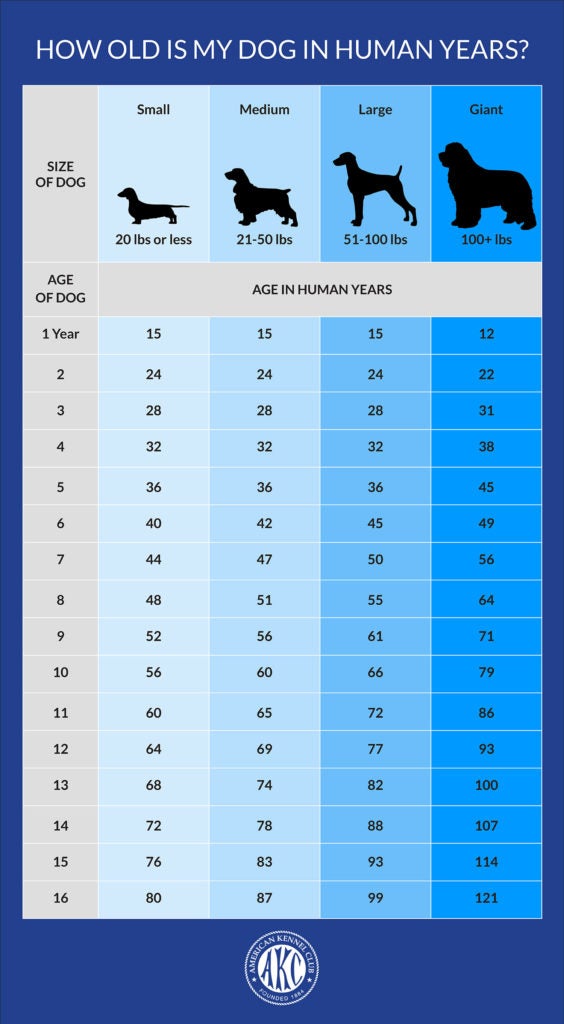What's 1 Year in Dog Years
Since the 1950s, the popular calculation of how old a dog was "in human years" has been that 1 dog year is the equivalent of 7 human ones. Even though this formula has been around for a surprisingly long time, the reality is not so cut-and-dried. That doesn't stop many people from defaulting to this traditional calculation. "You can't really kill the seven-year rule," says Kelly M. Cassidy, a curator of the Charles R. Connor Museum at Washington State University, who compiles studies about longevity in dogs.
One explanation for how this formula got started is that the 7:1 ratio seems to have been based on the statistic that people lived to about 70, and dogs to about 10.
"My guess is it was a marketing ploy," says William Fortney, a veterinarian at Kansas State University. He tells the Wall Street Journal that it was "a way to educate the public on how fast a dog ages compared to a human, predominantly from a health standpoint. It was a way to encourage owners to bring in their pets at least once a year."
How to Calculate Dog Years to Human Years?
As a general guideline, though, the American Veterinary Medical Association breaks it down like this:
- 15 human years equals the first year of a medium-sized dog's life.
- Year two for a dog equals about nine years for a human.
- And after that, each human year would be approximately five years for a dog.
How Do Researchers Come Up With Those Numbers?
There are many several factors to consider, so it's not possible to pin it down precisely, but the AVMA says: "Cats and small dogs are generally considered 'senior' at seven years old, but we all know they've got plenty of life left in them at that age. Larger-breed dogs tend to have shorter lifespans compared to smaller breeds and are often considered senior when they are 5 to 6 years of age. The 'senior' classification is based on the fact that pets age faster than people, and veterinarians start seeing more age-related problems in these pets. Contrary to popular belief, dogs do not age at a rate of 7 human years for each year in dog years."
An example would be the Great Dane. The average life expectancy, according to the Great Dane Club of America, is about 7–10 years. Therefore, a 4-year-old Great Dane would already be 35 in human years. Again, keep in mind that these are rough estimates.
The National Center for Health Statistics doesn't keep records for dogs. Instead, there are three main sources for data on their longevity: pet-insurance companies, breed-club surveys, and veterinary hospitals.
Why Do Smaller Dogs Live Longer than Larger Dogs?
This phenomenon has baffled scientists for years, and research has yet to explain the relationship between body mass and a dog's lifespan.
Generally speaking, large mammals, like elephants and whales, tend to live longer than small ones, like mice. So why do small dogs have a longer average life span than large breeds?
Large dogs age at an accelerated pace, and "their lives seem to unwind in fast motion," according to researcher Cornelia Kraus, an evolutionary biologist at the University of Göttingen in Germany, speaking to Inside Science. Scientists concluded that every 4.4 pounds of body mass reduced a dog's life expectancy by about a month. The reason why is still unknown, though Kraus puts forward several possibilities, including that larger dogs may succumb to age-related illnesses sooner and that the accelerated growth of large dogs may lead to a higher likelihood of abnormal cell growth and death from cancer. Scientists plan future studies to better explain the link between growth and mortality.

Canine gerontology is a burgeoning field of science, as dog lovers are looking to not only extend the time they have with their pets, but to improve the quality of that time. The Dog Aging Project is studying the aging process in dogs, using geroscience research to "delay aging and promote healthy longevity."
Whether measured in human years or dog years, as our dogs mature and age there is beauty and charm at every step along the way. With their gray muzzles and wise expressions, senior dogs are especially lovable and poignant.
2019 Epigenetic Clock Study
A 2019 study by researchers at the University of California San Diego put forth a new method for calculating dog age, based on changes made to human and dog DNA over time. In both species, methyl groups are added to DNA molecules throughout aging, altering DNA activity without altering the DNA itself. As a result, DNA methylation has been used by scientists to study aging in humans through an "epigenetic clock."
The research team performed targeted DNA sequencing in 104 Labrador Retrievers spanning a 16 year age range, in an attempt to compare dogs' epigenetic clocks to those of humans. The results allowed them to derive a formula for adjusting dogs' ages to "human years", by multiplying the natural logarithm of the dog's age by 16 and adding 31 (human_age = 16ln(dog_age) + 31).This natural logarithm calculator can help.
As the study included just a single breed, your own dog's "human age" based on this formula may not quite match up. It's known that different breeds age differently, so the UCSD formula may lack enough variables for conclusive results. Regardless, the new science-backed formula put forth is certainly more useful to those looking to calculate dogs' "human age" than the long-debunked "multiply by 7" myth.

Did You Know?
Evidently, people have been comparing human-to-dog years for centuries.
In 1268, the artisans creating the Cosmati Pavement in Westminster Abbey inscribed into the floor a prediction for Judgement Day: "If the reader wisely considers all that is laid down, he will find here the end of the primum mobile; a hedge lives for three years, add dogs and horses and men, stags and ravens, eagles, enormous whales, the world: each one following triples the years of the one before."
By this math, a dog lives to nine, a man to 80. If these statistics were accurate, between 1268 and the mid-20th century, dogs had a year trimmed off their lifespan, and we lost almost a decade. Luckily for both species, our lifespans have gone in the other direction.
Source: https://www.akc.org/expert-advice/health/how-to-calculate-dog-years-to-human-years/
0 Response to "What's 1 Year in Dog Years"
Post a Comment